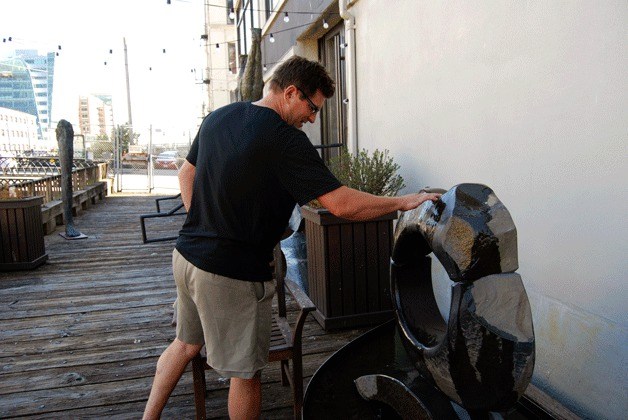Unlike other artist studios, one doesn’t just walk into sculptor Will Robinson’s work room.
Robinson’s “studio” is an outdoor construction site complete with three cranes, industrial-sized saws fit to cut through boulders, lots of dust and piles and piles of rock.
“Once you get past a few hundred pounds, or even a couple thousand pounds, you need something to lift it,” Robinson said.
“You do what you need to do to fulfill what creative ideas you have,” he said.
This includes using cranes. It’s how he managed to transfer more than 40 of his sculptures from his studio in Bremerton, past his home on Bainbridge, and into the Foster White Gallery in Seattle where he will be exhibiting “Collaborations of Man and Nature” through August.
It’s Robinson’s 16th year showing at Foster White Gallery, and every time he brings in a few more new pieces, he parks his crane across the street.
Robinson’s work includes basalt and the varieties of granite in a wide range of sizable pieces, from outdoor benches and fountains to floor pieces that reach 6 feet high. It’s the kind of work one can touch or sit on.
Like other kids in the Puget Sound area, Robinson grew up collecting rocks off the Bremerton beach. He started carving small pieces. Eventually these small pieces led to boulder-size pieces, and the tools and skills accumulated alongside the rock collection.
By his late 20s he was on his way to becoming a well-known Northwestern sculptor. Among other pieces he has done in Bremerton’s harbor side, he is most known for the “Orca Whale Pod” he installed at Lions Field Park in 2011.
“I always liked stones the best,” Robinson said. “I like that it’s difficult to work. It’s got a kind of a lot of mysterious characters in that when you get into this kind of deal, you don’t really know what you’re going to get. But most of all, I kind of have an attraction to the basic materials.”
The basic integral materials that our civilization is built on are metals, wood, glass and stone, Robinson explained. When these materials remain the basis of a creation, the simplicity and durability draws him in.
“If you had this sculpture, and you came over and liked it, and I said, ‘Oh yeah, it’s made out of foam, and I painted it and made it all look like this,’ Robinson said. “You’d probably think, well I don’t like it as much anymore. At least, I wouldn’t.”
The clarity of natural elements like stone offers viewers beauty in art without the noise of a jumbled conception.
“I choose to kind of abstain from, I call, the over-emphasis on the concept of the work versus the actual physical manifestation of it,” Robinson explained.
This difference in time spent on conceptualization versus creation can be related to Robinson’s affinity to stone as his principle material.
The massive stones are hard to bend into a concept. If Robinson were able to mold it, he would be making pottery. But Robinson isn’t a molder or a potter. Instead of working against it, he works with it. Instead of over-thinking his creations, when he gets an idea, he turns on the saw.
What has come out of that, is both whimsical and rugged. Each piece defies the predictability of man-made geometry, and takes on the natural rhythms and shapes of earth.
His sculpture exhibit will be open for viewers from 10 a.m. to 6 p.m., Tuesdays through Saturdays at the Foster White Gallery, located at 220 Third Ave. in Seattle.



